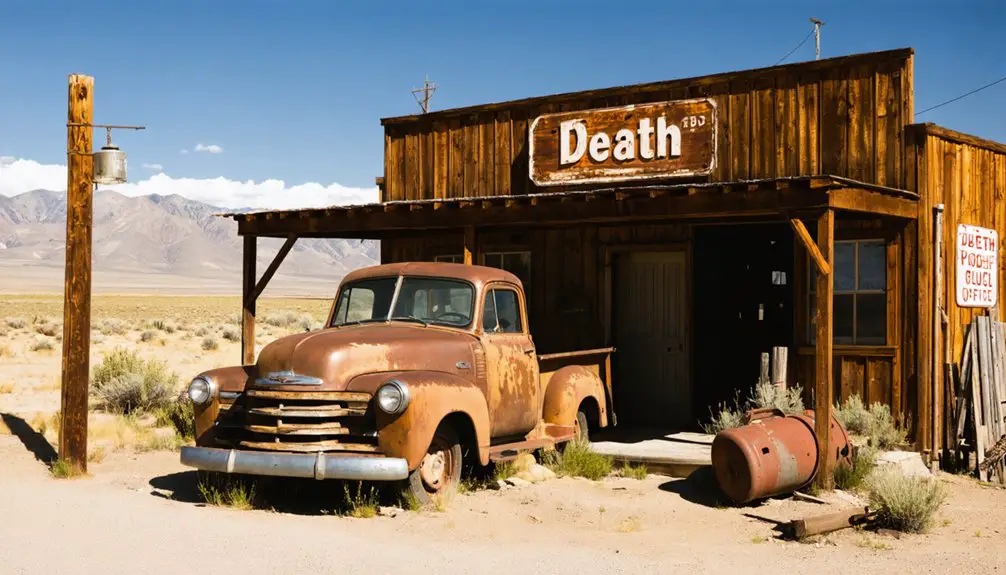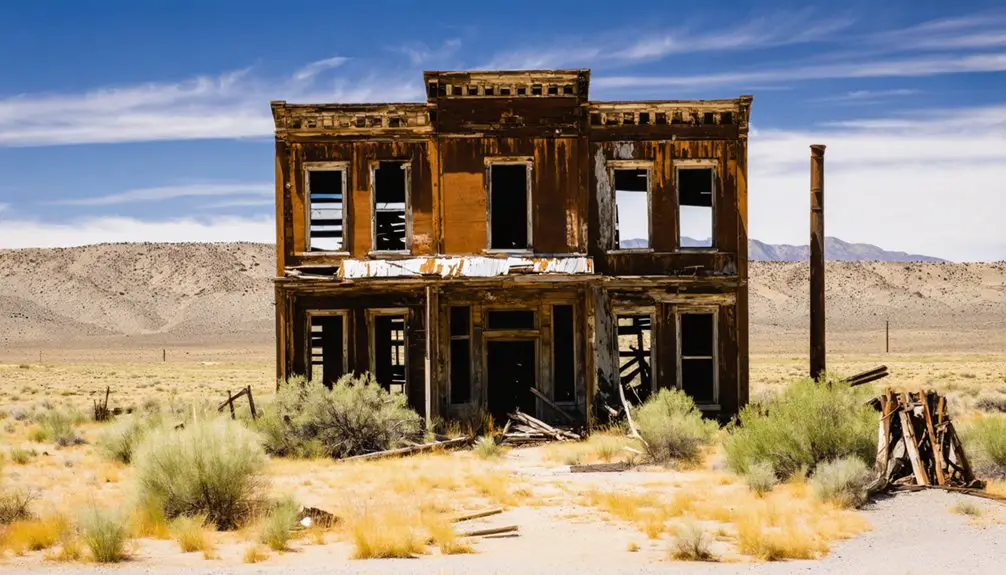You’ll find Deeth, Nevada nestled along the Humboldt River, where Native American seasonal camps gave way to a thriving railroad town in the 1860s. At its peak in 1912, this cultural oasis boasted 250 residents, five saloons, an opera house, and the bustling Deeth Mercantile Company. After devastating fires and the rise of automobiles, the town declined, though its Cold War role as a radar bombing target site adds another fascinating layer to its complex past.
Key Takeaways
- Deeth began as a bustling railroad town in the 1860s, featuring hotels, saloons, and a mercantile company before declining to near-ghost town status.
- The town’s devastating 1915 fire destroyed key buildings including the opera house and hotels, marking the beginning of its decline.
- Currently home to around 20 residents, Deeth maintains its post office while most historic structures stand abandoned or in ruins.
- Military remnants from 1960s Cold War operations, including radar bombing target sites, are still visible in the town’s landscape.
- Located along the California Trail and Humboldt River, Deeth originated as a Shoshone gathering site before European settlement.
From Native Settlement to Railroad Boom
While the Shoshone people originally used Deeth as a seasonal camp for gathering pine nuts and other resources along the Humboldt River, the area’s significance grew dramatically with the arrival of Euro-American settlers in the 1840s.
The Shoshone’s seasonal gathering grounds transformed into a vital settlement as Euro-American pioneers arrived, forever changing the landscape of Deeth.
You’ll find evidence of cultural exchange as Native Americans traded with emigrants for firearms and metal goods, though this interaction came at a devastating cost to native resources and populations through disease and conflict.
Similar to the Mormon Fort in Las Vegas, early settlers established outposts to support westward expansion.
The California Trail brought thousands through Deeth between 1841-1851, transforming the region from a seasonal gathering place to a crucial waypoint. The valley’s knee-high grass near the river provided vital sustenance for weary travelers and their livestock.
When the Transcontinental Railroad arrived in the late 1860s, you’d have witnessed Deeth’s evolution into a bustling stop along the rails, marking its change from Native American territory to an essential transportation hub.
The Rise of a Cultural Desert Oasis
Despite its remote desert location, Deeth transformed into a vibrant cultural oasis during the railroad boom years, boasting amenities you’d expect to find in much larger frontier towns.
The town’s cultural heritage centered around its opera house, where a local orchestra performed, while cowpunchers staged theatrical Old West shows for railroad travelers and new settlers. Like the nearby town of Palisade Station, Deeth experienced its share of Wild West rowdiness with frequent saloon brawls and shootouts. Similar to the historic Basque cuisine scene in Elko County, Deeth featured several distinctive restaurants catering to diverse cultural tastes.
You’d have found a thriving community identity expressed through lively dance halls and saloons, with multiple businesses like general stores and creameries adding to the social fabric.
During its peak, Deeth represented more than just another desert whistle-stop – it was a genuine cultural crossroads where the isolation of the Nevada desert gave way to a spirited entertainment scene that defined the town’s character and drew visitors from across the region.
Commerce and Community Life
You’d find a bustling business district in early Deeth, where five saloons, two hotels, and multiple merchants served both locals and travelers passing through on the Central Pacific Railroad.
The town’s cultural scene thrived with an opera house, orchestra, and dance halls providing entertainment for its peak population of 250 residents around 1912. The town grew alongside the J.R. Bradley Cattle Company, which established a new hotel in the area.
The Deeth Mercantile Company‘s 4,000-square-foot building anchored the commercial district, while establishments like the creamery, producing 200 pounds of butter weekly, and the blacksmith shop kept the local economy humming. The devastating 1915 major fire destroyed most of the town’s structures, marking the beginning of its decline.
Bustling Business District
In 1895, Deeth’s business district buzzed with remarkable commercial activity for a frontier town of its size, boasting two expansive general stores, five saloons, and two hotels that served both locals and travelers.
You’d find the impressive Deeth Mercantile Company anchoring the district with its 4,000-square-foot establishment, while the town’s commercial evolution reflected the dynamic needs of a growing community. Like Metropolis’ grand hotel, these establishments represented the ambitious spirit of Nevada’s planned communities.
The social dynamics of Deeth’s business scene included:
- A thriving dance hall and opera house for entertainment
- A bustling red light district that shaped the town’s character
- Essential services like a livery stable, blacksmith, and slaughterhouse
Entertainment and Social Scene
Life in Deeth revolved around three distinctive entertainment hubs: the grand opera house, the lively dance hall, and a collection of five saloons that defined the town’s vibrant social scene.
You’d find yourself immersed in a rich tapestry of performance arts, from orchestral concerts at the opera house to impromptu Old West shows staged by local cowpunchers. Much like Virginia City’s boardwalks, these venues created an authentic frontier atmosphere.
Social gatherings flourished at the 4,000-square-foot Deeth Mercantile Company, where residents would catch up on local news while shopping. The town’s two hotels hosted dinners and meetings, while the creamery became an informal meeting spot for neighbors exchanging stories.
Fires, Automobiles, and the Path to Decline
During the early 20th century, Deeth faced two formidable challenges that would ultimately seal its fate as a ghost town. Fire devastation struck repeatedly between 1913-1938, with the most destructive blaze in 1915 leveling most of the town’s wooden structures. Like many towns across Nevada that collectively consumed 700 gallons of gas during ghost town exploration ventures, Deeth’s landscape bears the scars of its dramatic past.
The automobile impact dealt another blow, as the rise of cars diminished Deeth’s importance as a railroad hub.
You’ll find these key events transformed Deeth from a bustling frontier town to near abandonment:
- The fires destroyed the opera house, hotels, and numerous businesses that once supported 250 residents
- Automobiles allowed people to bypass small railroad towns, leading to closure of essential services
- By the mid-20th century, the population had dwindled to just twenty, with most original structures gone
Cold War Echoes and Modern Remnants

While Deeth’s early decline seemed to mark its final chapter, the Cold War unexpectedly brought new purpose to this near-abandoned railway town.
In 1963, the U.S. Air Force transformed Deeth into a radar bombing target site, stationing specialized RBS Express equipment for electronic warfare training. B-47 and B-52 bombers conducted simulated bombing runs overhead for up to 20 hours daily.
You’ll find traces of this military legacy scattered across Deeth’s landscape today. The town’s strategic location, roughly 65 miles north of the Nevada Test Site, made it an ideal spot for Cold War operations. The signing of the Partial Test Ban Treaty that year reshaped how nuclear testing was conducted across Nevada’s military installations.
Air Force personnel, though restricted by strict safety protocols, briefly revived the ghost town’s pulse. Now, Deeth’s remaining structural ruins stand as silent witnesses to America’s nuclear deterrence strategy of the 1960s.
Living Legacy in Nevada’s History
You’ll find fascinating traces of Deeth’s cultural significance in its former opera house, where traveling performers and local musicians once entertained settlers with theatrical shows and orchestral music.
The town’s resilience through multiple devastating fires and economic shifts speaks to the tenacious spirit that defined Nevada’s rural communities in the late 1800s and early 1900s.
Though Deeth’s population has dwindled to around twenty residents today, its continued existence as a ranching community maintains an unbroken link to Nevada’s pioneering agricultural heritage.
Opera House Cultural Impact
Since its establishment in the 1920s, the Amargosa Opera House has profoundly shaped Nevada’s cultural landscape as a beacon of artistic expression in the remote desert.
You’ll discover how this historic venue transformed from a company town theater into an internationally recognized cultural pilgrimage site, drawing visitors like Ray Bradbury and Red Skelton.
Marta Becket’s forty-year dedication to performing weekly shows turned this desert jewel into a symbol of artistic perseverance.
- The Opera House’s stunning murals, painted by Becket herself, create an immersive artistic experience
- Weekly performances and cultural events keep the desert’s artistic spirit alive
- The venue’s influence extends beyond its walls, inspiring a new generation of performers like Jenna McClintock
Rural Resilience Through Time
Although Deeth began as a modest Shoshone seasonal camp, this resilient Nevada settlement evolved into a significant transportation hub that shaped the region’s development for generations.
You’ll find that Deeth’s resilience strategies centered on diversifying its economic base, from railroad operations to ranching and agriculture, while maintaining important communication links through its telegraph and telephone stations.
The town’s community adaptation shines through its response to challenges like the devastating 1915 fire and the shift from rail to automobile travel.
Even as the Cold War brought B-52 bombers overhead and modern times changed the landscape, Deeth’s residents demonstrated remarkable staying power.
While the population has dwindled, the preservation of essential services like the post office reflects the enduring spirit of Nevada’s rural communities.
Frequently Asked Questions
What Caused Tensions Between Native Americans and Early Settlers in Deeth?
You’ll find that land disputes ignited fierce conflicts, as settlers disrupted Native hunting grounds and water sources. Cultural misunderstandings escalated when newcomers failed to respect traditional Shoshone seasonal patterns and territories.
How Did Extreme Weather Events Affect Daily Life in Deeth?
As they say, weather makes or breaks you. You’d face brutal weather patterns year-round, from subzero winters to scorching summers, creating daily struggles with farming, travel, heating, and basic survival.
Were There Any Famous Crimes or Notorious Outlaws in Deeth?
You won’t find famous criminals or notorious events in Deeth’s history. The town served mainly as a peaceful railroad and ranching community, avoiding the outlaw troubles common to Nevada’s mining boomtowns.
What Traditional Native American Artifacts Have Been Found Around Deeth?
You’ll find ancient Clovis points, hunting slings, sandals, and ground stone tools around Deeth. Traditional tools like metates and ceremonial items from burial sites reveal rich Northern Paiute heritage.
Did Any Hollywood Movies or Television Shows Feature Deeth’s Ghost Town?
You won’t find any documented film references or TV shows featuring Deeth’s ghost town. While Nevada’s abandoned places draw Hollywood’s attention, there’s no evidence of productions using this remote location’s ruins.
References
- https://nvtami.com/2024/10/26/deeth-joshing-the-greenhorns/
- https://www.ghosttowns.com/states/nv/deeth.htm
- https://www.nvexpeditions.com/elko/deeth.php
- https://nvtami.com/2025/01/16/exploring-elko-county-ghost-towns/
- https://travelnevada.com/ghost-town/the-metropolis-that-wasnt/
- https://en.wikibooks.org/wiki/History_of_Nevada/Native_American
- https://www.clarkcountynv.gov/government/departments/parks___recreation/wetlands_park/culturalhistory
- https://shpo.nv.gov/uploads/documents/McBride_-_Exploration_and_Early_Settlement_in_NV
- https://nevadamagazine.com/issue/fall-2022/20513/
- https://nevadamagazine.com/issue/november-december-2019/11696/



